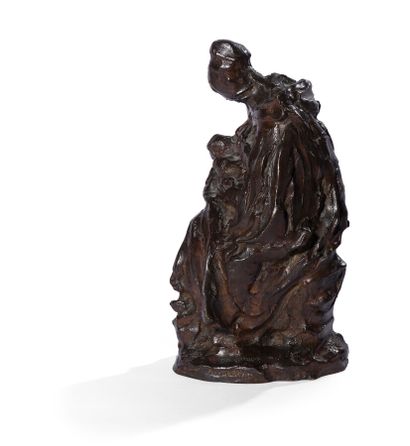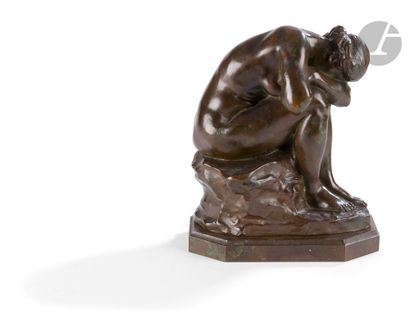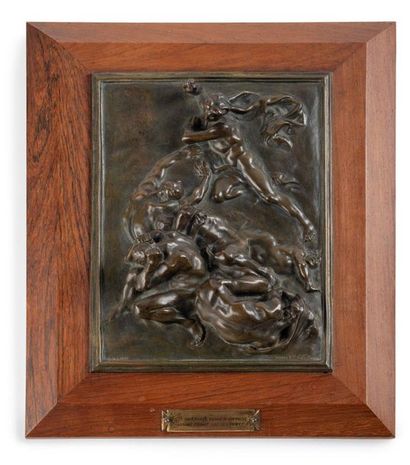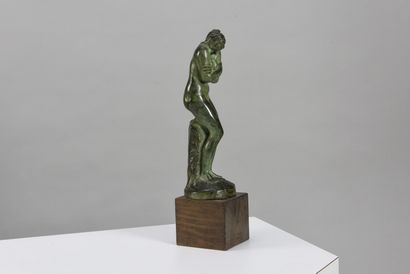Aimé-Jules Dalou (1838-1902): A sculpted white marble figure of 'La Verité Meconnue (The Truth Unacknowledged)'The seated female nude leaning on her knees and hiding her face in her hair, the trailing hair knotted in a chignon, beside a cracked mirror (facing to the front) on an integral naturalistic canted rectangular base, signed DALOU, 24.5cm high, 21cm longFootnotesRecognised today as one of the premier sculptors of 19th century France, Aimé-Jules Dalou was admired for his perceptiveness, free execution, and unpretentious realism. In his day he was revered in exactly the same manner as his friend and contemporary Rodin would subsequently be to later generations. Studying under Jean Baptiste Carpeaux, who persuaded his parents to allow him to enrol to study sculpture at the Petite Ecole and the Ecole des Beaux Arts, Dalou subsequently became one of the most versatile and outstanding French sculptors of the 19th century. He exhibited at the Paris Salon as early as 1861 but was refused the prestigious Prix de Rome which would have done much to further his career due to his political leanings and his opposition to the government during the Second Empire period. He subsequently began exhibiting at the so-called Salon des Refusés. However, ironically his sculpture of 'Daphnis and Chloe' was subsequently purchased by the French state after it was shown at the Salon in 1869 and he also won worldwide acclaim with his life-size plaster figure of the 'Embroiderer' at the Salon in 1870, both of which illustrated and re-enforced his interest in the female form. Vehemently opposed to the classicism which dominated sculpture, he fled to England after the crushed revolution of 1871 in which he took an active part supporting the Paris Commune whilst curator of the Musee du Louvre under Gustave Courbet Settling in London, he taught sculpture at South Kensington and was to greatly influence the trend in late 19th century English sculpture towards greater naturalism. Dalou finally returned to Paris after a pardon from the French government and became a founder member of the Société Nationale des Beaux Arts in 1890. The present figure of Verité Méconnue was originally modelled on Dalou's return to his homeland in that same year. Related Literature A. Simier, Jules Dalou Le sculpteur de la République, exh. cat., Petit Palais - Musées des Beaux-Arts de la Ville de Paris, Paris, 2013. J. Hunisak, The sculptor Jules Dalou studies in his style and imagery, New York, 1977.
Aimé-Jules Dalou (1838-1902): A sculpted white marble figure of 'La Verité Meconnue (The Truth Unacknowledged)'The seated female nude leaning on her knees and hiding her face in her hair, the trailing hair knotted in a chignon, beside a cracked mirror (facing to the front) on an integral naturalistic canted rectangular base, signed DALOU, 24.5cm high, 21cm longFootnotesRecognised today as one of the premier sculptors of 19th century France, Aimé-Jules Dalou was admired for his perceptiveness, free execution, and unpretentious realism. In his day he was revered in exactly the same manner as his friend and contemporary Rodin would subsequently be to later generations. Studying under Jean Baptiste Carpeaux, who persuaded his parents to allow him to enrol to study sculpture at the Petite Ecole and the Ecole des Beaux Arts, Dalou subsequently became one of the most versatile and outstanding French sculptors of the 19th century. He exhibited at the Paris Salon as early as 1861 but was refused the prestigious Prix de Rome which would have done much to further his career due to his political leanings and his opposition to the government during the Second Empire period. He subsequently began exhibiting at the so-called Salon des Refusés. However, ironically his sculpture of 'Daphnis and Chloe' was subsequently purchased by the French state after it was shown at the Salon in 1869 and he also won worldwide acclaim with his life-size plaster figure of the 'Embroiderer' at the Salon in 1870, both of which illustrated and re-enforced his interest in the female form. Vehemently opposed to the classicism which dominated sculpture, he fled to England after the crushed revolution of 1871 in which he took an active part supporting the Paris Commune whilst curator of the Musee du Louvre under Gustave Courbet Settling in London, he taught sculpture at South Kensington and was to greatly influence the trend in late 19th century English sculpture towards greater naturalism. Dalou finally returned to Paris after a pardon from the French government and became a founder member of the Société Nationale des Beaux Arts in 1890. The present figure of Verité Méconnue was originally modelled on Dalou's return to his homeland in that same year. Related Literature A. Simier, Jules Dalou Le sculpteur de la République, exh. cat., Petit Palais - Musées des Beaux-Arts de la Ville de Paris, Paris, 2013. J. Hunisak, The sculptor Jules Dalou studies in his style and imagery, New York, 1977.














Testen Sie LotSearch und seine Premium-Features 7 Tage - ohne Kosten!
Lassen Sie sich automatisch über neue Objekte in kommenden Auktionen benachrichtigen.
Suchauftrag anlegen